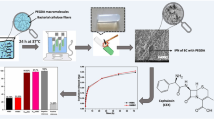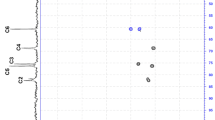Abstract
Cyclodextrin-based hydrogels have been described as suitable for the controlled-release of bioactive molecules to be used as wound dressing. These materials have major advantages, since they gather the hydrogel properties (high degree of swelling and easy manipulation) and the encapsulation ability of cyclodextrins. β-cyclodextrin (β) or hydroxypropyl-β-cyclodextrin (HPβ) was cross-linked (1,4-butanediol diglycidyl ether) with hydroxypropyl methylcellulose under mild conditions. The hydrogels were chemically characterized by swelling degree, FTIR, DSC and contact angle. The gallic acid loading and release was also analysed, as well the antibacterial activity and cytotoxicity of the polymeric networks. The hydrogels obtained were firm and transparent, with good swelling ability. The gel-HPβ had a surface more hydrophilic when compared with the gel-β. Nevertheless, both hydrogels were capable to incorporate gallic acid and sustain the release for 48 h. The antibacterial activity of gallic acid was maintained after its adsorption within the polymeric matrix, as well as, gallic acid effect on fibroblast proliferation. Therefore, gel-β and gel-HPβ conjugated with gallic acid were shown to be a viable option for antibacterial wound dressing.








Similar content being viewed by others
References
Blanco-Fernandez B, Lopez-Viota M, Concheiro A, Alvarez-Lorenzo C (2011) Synergistic performance of cyclodextrin-agar hydrogels for ciprofloxacin delivery and antimicrobial effect. Carbohydr Polym 85:765–774. doi:10.1016/j.carbpol.2011.03.042
Borges A, Ferreira C, Saavedra MJ, Simões M (2013) Antibacterial activity and mode of action of ferulic and gallic acids against pathogenic bacteria. Microb Drug Resist 19:256–265. doi:10.1089/mdr.2012.0244
Challa R, Ahuja A, Ali J, Khar RK (2005) Cyclodextrins in drug delivery: an updated review. Aaps Pharmscitech 6:329–357
Chen L, Wu J, Yuwen L et al (2009) Inclusion of tetracycline hydrochloride within supramolecular gels and its controlled release to bovine serum albumin. Langmuir 25:8434–8438. doi:10.1021/la8043208
Ciolacu D, Oprea AM, Anghel N et al (2012) New cellulose–lignin hydrogels and their application in controlled release of polyphenols. Mater Sci Eng C 32:452–463. doi:10.1016/j.msec.2011.11.018
Da Rosa CG, Borges CD, Zambiazi RC et al (2013) Microencapsulation of gallic acid in chitosan, beta-cyclodextrin and xanthan. Ind Crops Prod 46:138–146. doi:10.1016/j.indcrop.2012.12.053
Dandekar PP, Jain R, Patil S et al (2010) Curcumin-loaded hydrogel nanoparticles: application in anti-malarial therapy and toxicological evaluation. J Pharm Sci 99:4992–5010. doi:10.1002/jps.22191
Fang Z, Bhandari B (2010) Encapsulation of polyphenols—a review. Trends Food Sci Technol 21:510–523. doi:10.1016/j.tifs.2010.08.003
Garcia-Fernandez MJ, Brackman G, Coenye T et al (2013) Antiseptic cyclodextrin-functionalized hydrogels and gauzes for loading and delivery of benzalkonium chloride. Biofouling 29:261–271. doi:10.1080/08927014.2013.765947
Grice E, Segre J (2011) The skin microbiome. Nat Rev Microbiol 9:244–253. doi:10.1038/nrmicro2537
Guimaraes R, Barros L, Carvalho A, Ferreira ICFR (2010) Studies on chemical constituents and bioactivity of rosa micrantha: an alternative antioxidants source for food, pharmaceutical, or cosmetic applications. J Agric Food Chem 58:6277–6284. doi:10.1021/jf101394w
Gulrez SKH, Al-Assaf S, Phillips GO (2011) Hydrogels: methods of preparation, characterisation and applications. In: Carpi A (ed) Progress in molecular and environmental bioengineering—from analysis and modeling to technology applications, 1st edn. Inthech, Croatia, pp 117–150
Jones D, Lorimer C, McCoy C, Gorman S (2008) Characterization of the physicochemical, antimicrobial, and drug release properties of thermoresponsive hydrogel copolymers designed for medical device applications. J Biomed Mater Res B Appl Biomater 85:417–426. doi:10.1002/jbm.b.30960
Lorenzo A, Rodríguez-Tenreiro C, Torres Labandeira JJ, Concheiro Nine A (2008) Method of obtaining hydrogels of cyclodextrins with glycidyl ethers, compositions thus obtained and applications Thereof. US Pat. App. 11/2
M2-A8 (2005) Padronização dos testes de sensibilidade a antimicrobianos por disco-difusão: Norma Aprovada. 23:1–58
Miranda T, Goff A Le, Pereira A, Soares G (2010) Studies on cotton modification with dodecenyl succinic anhydride (DDSA). In: Technology U of ZF of T (ed) 5th Int. Text. Cloth. Des. Conf.—Magic World Text. Dubrovnik, pp 1–6
Nicoletti A, Fiorini M, Paolillo J et al (2013) Effects of different crosslinking conditions on the chemical-physical properties of a novel bio-inspired composite scaffold stabilised with 1,4-butanediol diglycidyl ether (BDDGE). J Mater Sci Mater Med 24:17–35. doi:10.1007/s10856-012-4782-4
Pinho E (2014) Development of a new antimicrobial material for wound dressing. Universirty of Minho, Braga, Portugal
Pinho E, Grootveld M, Soares G, Henriques M (2013) Cyclodextrin-based hydrogels toward improved wound dressings. Crit Rev Biotechnol 8551:1–10. doi:10.3109/07388551.2013.794413
Pinho E, Ferreira ICFR, Barros L et al (2014a) Antibacterial potential of northeastern portugal wild plant extracts and respective phenolic compounds. Biomed Res Int 2014:814590. doi:10.1155/2014/814590
Pinho E, Grootveld M, Soares G, Henriques M (2014b) Cyclodextrins as encapsulation agents for plant bioactive compounds. Carbohydr Polym 101:121–135. doi:10.1016/j.carbpol.2013.08.078
Rodriguez-Tenreiro C, Alvarez-Lorenzo C, Rodriguez-Perez A et al (2006) New cyclodextrin hydrogels cross-linked with diglycidylethers with a high drug loading and controlled release ability. Pharm Res 23:121–130. doi:10.1007/s11095-005-8924-y
Rodriguez-Tenreiro C, Alvarez-Lorenzo C, Rodriguez-Perez A et al (2007) Estradiol sustained release from high affinity cyclodextrin hydrogels. Eur J Pharm Biopharm Off J Arbeitsgemeinschaft fur Pharm Verfahrenstechnik eV 66:55–62
Schwingel L, Fasolo D, Holzschuh M et al (2008) Association of 3-O-methylquercetin with β-cyclodextrin: complex preparation, characterization and ex vivo skin permeation studies. J Incl Phenom Macrocycl Chem 62:149–159. doi:10.1007/s10847-008-9450-4
Siepmann J, Peppas NA (2001) Modeling of drug release from delivery systems based on hydroxypropyl methylcellulose (HPMC). Adv Drug Deliv Rev 48:139–157
Sun R, Sun X, Tomkinson I (2003) Hemicelluloses and their derivatives. In: Gatenholm P, Tenkanen M (eds) Hemicelluloses: science and technology. American Chemical Society, Washington, DC, pp 2–22. doi:10.1021/bk-2004-0864.ch001
Thatiparti TR, Shoffstall AJ, Recum H (2010) Cyclodextrin-based device coatings for affinity-based release of antibiotics. Biomaterials 31:2335–2347. doi:10.1016/j.biomaterials.2009.11.087
Wang YX, Robertson JL, Spillman WB, Claus RO (2004) Effects of the chemical structure and the surface properties of polymeric biomaterials on their biocompatibility. Pharm Res 21:1362–1373
Wang X, Wang J, Yang N (2007) Flow injection chemiluminescent detection of gallic acid in olive fruits. Food Chem 105:340–345. doi:10.1016/j.foodchem.2006.11.061
Yasuda H, Sharma AK, Yasuda T (1981) Effect of orientation and mobility of polymer molecules at surfaces on contact angle and its hysteresis. J Polym Sci Polym Phys Ed 19:1285–1291. doi:10.1002/pol.1981.180190901
Yasuda T, Okuno T, Yasuda H (1994) Contact angle of water on polymer surfaces. Langmuir 10(7):2435–2439. doi:10.1021/la00019a068
Zhang J-T, Huang S-W, Liu J, Zhuo R-X (2005) Temperature sensitive poly[N-isopropylacrylamide-co-(acryloyl beta-cyclodextrin)] for improved drug release. Macromol Biosci 5:192–196. doi:10.1002/mabi.200400167
Zhang L, Zhou J, Zhang L (2013) Structure and properties of β-cyclodextrin/cellulose hydrogels prepared in NaOH/urea aqueous solution. Carbohydr Polym 94:386–393. doi:10.1016/j.carbpol.2012.12.077
Zugasti ME, Zornoza A, Goñi MDM et al (2009) Influence of soluble and insoluble cyclodextrin polymers on drug release from hydroxypropyl methylcellulose tablets. Drug Dev Ind Pharm 35:1264–1270. doi:10.1080/03639040902882306
Acknowledgments
The authors thank the FCT Strategic Projects PEst-OE/EQB/LA0023/2013, PEst-C/CTM/UI0264/2011, the Project “BioHealth—Biotechnology and Bioengineering approaches to improve health quality”, Ref. NORTE-07-0124-FEDER-000027, co-funded by the Programa Operacional Regional do Norte (ON.2—O Novo Norte), QREN, FEDER, and E. Pinho grant (SFRH/BD/62665/2009).
Author information
Authors and Affiliations
Corresponding author
Rights and permissions
About this article
Cite this article
Pinho, E., Henriques, M. & Soares, G. Cyclodextrin/cellulose hydrogel with gallic acid to prevent wound infection. Cellulose 21, 4519–4530 (2014). https://doi.org/10.1007/s10570-014-0439-4
Received:
Accepted:
Published:
Issue Date:
DOI: https://doi.org/10.1007/s10570-014-0439-4




